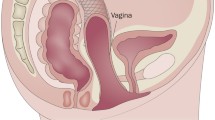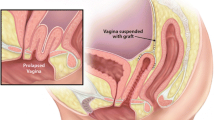Abstract
Abdominal sacrocolpopexy (SCP) has been considered one of the gold standard surgical procedures for correction of apical pelvic organ prolapse, with high success rates and few complications (Maher et al. Database Syst Rev, 2013). Minimally invasive SCP has been shown to have the additional benefit of reduced blood loss and decreased hospital length of stay, without compromising anatomic or subjective outcomes (Freeman et al. Int Urogynecol J 24:377–84, 2013). This report summarizes the latest literature on minimally invasive SCP, with a focus on outcomes and efficiency. Recent randomized controlled trials (RCT) have shown equivalent subjective and anatomic outcomes for robotic SCP (RSCP) and laparoscopic SCP (LSCP), with increased operative time and cost associated with RSCP.
Similar content being viewed by others
References
Papers of particular interest, published recently, have been highlighted as: • Of importance
Maher C, Feiner B, Baessler K, et al. Surgical management of pelvic organ prolapse in women. Cochrane Database Syst Rev. 2013;4:1–30.
Freeman RM, Pantazis, Thomson A, et al. A randomized controlled trial of abdominal versus laparoscopic sacrocolpopexy for the treatment of post-hysterectomy vaginal vault prolapse: LAS study. Int Urogynecol J. 2013;24:377–84. This RCT compared LSCP to open SCP. Results showed LSCP to be equivalent in anatomic and subjective outcomes at 1 year, with the laparoscopic approach also having reduced blood loss and shorted hospital stay.
Nygaard IE, McCreery R, Brubaker L, et al. Abdominal sacrocolpopexy: a comprehensive review. Obstet Gynecol. 2004;104:805–23.
Nygaard IE, Brubaker L, Zyczynski HM, et al. Long-term outcomes following abdominal sacrocolpopexy for pelvic organ prolapse. JAMA. 2013;309:2016–24.
Wright JD, Ananth C, Lewin SN, et al. Robotically assisted versus laparoscopic hysterectomy among women with benign gynecologic disease. JAMA. 2013;309:689–98. This population-based analysis of benign hysterectomies performed from 2007 to 2010 highlights an increase in minimally invasive surgical approaches to hysterectomy, with a concomitant decline in open and transvaginal hysterectomy rates.
Nezhat CH, Nezhat F, Nezhat C. Laparoscopic sacral colpopexy for vaginal vault prolapse. Obstet Gynecol. 1994;84(5):885–8.
Geller EJ, Siddiqui NY, Wu JM, et al. Short-term outcomes of robotic sacrocolpopexy compared with abdominal sacrocolpopexy. Obstet Gynecol. 2008;112:1201–6.
Geller EJ, Parnell BA, Dunivan GC. Robotic vs abdominal sacrocolpopexy: 44-month pelvic floor outcomes. Urology. 2012;79:532–6.
Siddiqui NY, Geller EJ, Visco AG. Symptomatic and anatomic 1-year outcomes after robotic and abdominal sacrocolpopexy. Am J Obstet Gynecol. 2012;206:435.e1–5.
Nosti PA, Umoh A, Kane S, et al. Outcomes of abdominal and minimally invasive sacrocolpopexy: a retrospective cohort study. Female Pelvic Med Reconstr Surg. 2014;20:33–7.
Tan-Kim J, Menefee SA, Luber KM, et al. Robotic-assisted and laparoscopic sacrocolpopexy: comparing operative times, costs and outcomes. Female Pelvic Med Reconstr Surg. 2011;17:44–9.
Paraiso MF, Jelovsek JE, Frick A, Chen CC, Barber MD. Laparoscopic compared with robotic sacrocolpopexy for vaginal prolapse: a randomized controlled trial. Obstet Gynecol. 2011;118:1005–13. This RCT of LSCP to RSCP showed equivalent anatomic and subjective outcomes at 1 year, but with increased operative time and increased postoperative pain in early postoperative period in the RSCP.
Anger JT, Mueller ER, Tarnay C, Smith B, Stroupe K, Rosenman A, et al. Robotic compared with laparoscopic sacrocolpopexy: a randomized controlled trial. Obstet Gynecol. 2014;123:5–12. This RCT of LSCP to RSCP showed equivalent anatomic and subjective outcomes at 6 months, but with increased operative time and cost for the RSCP.
Elliott DS, Krambeck AE, Chow GK. Long-term results of robotic assisted laparoscopic sacrocolpopexy for the treatment of high-grade vaginal vault prolapse. J Urol. 2006;176:655–9.
Akl MN, Long JB, Giles DL, et al. Robotic-assisted sacrocolpopexy: technique and learning curve. Surg Endosc. 2009. doi:10.1007/s00464-008-0311-4.
Geller EJ, Lin FC, Matthews CA. Analysis of robotic performance times to improve operative efficiency. J Minim Invasive Gynecol. 2013;20:43–8.
Geller EJ, Matthews CA. Impact of robotic operative efficiency on profitability. Obstet Gynecol. 2013;209:20.e1–5.
Brubaker L, Nygaard I, Richter HE, Visco A, Weber AM, Cundiff GW, et al. Two-year outcomes after sacrocolpopexy with and without Burch to prevent stress urinary incontinence. Obstet Gynecol. 2008;112:49–55.
Lowman JK, Woodman PJ, Nosti PA, et al. Tobacco use is risk factor for mesh erosion after abdominal sacral colpoperineopexy. Am J Obstet Gynecol. 2008;198:561.e1–4.
Wu JM, Wells EC, Hundley AF, et al. Mesh erosion in abdominal sacral colpopexy with and without concomitant hysterectomy. Am J Obstet Gynecol. 2006;194:1418–22.
Food and Drug Administration. Quantitative assessment of the prevalence of unsuspected uterine sarcoma in women undergoing treatment of uterine fibroids: summary and key findings. Silversprings: FDA; 2014. Available at: http://www.fda.gov/downloads/MedicalSafety/AlertsandNotices/UCM393589.pdf.
Hill AJ, Carroll AW, Matthews CA. Unanticipated uterine pathologic finding after morcellation during robotic-assisted supracervical hysterectomy and cervicosacropexy for uterine prolapse. Female Pelvic Med Reconstr Surg. 2014;20:113–5.
AUGS Position Statement: Laparoscopic Uterine Power Morcellation in Hysterectomy and Myomectomy FDA Safety Communication and ACOG Special Report. 2014. Online at http://www.augs.org/p/bl/et/blogid=16&blogaid=201.
Nosti PA, Carter CM, Sokol AJ, et al. Transvaginal versus transabdominal placement of synthetic mesh at time of sacrocolpopexy. J Minim Invasive Gynecol. 2014;21:S1–S24.
Von Pechmann WS, Aungst MJ, Gruber DD, et al. A pilot study on vaginally assisted laparoscopic sacrocolpopexy for patients with uterovaginal prolapse. Female Pelvic Med Reconstr Surg. 2011;17:115–9.
Tan-Kim J, Menefee SA, Luber KM, et al. Prevalence and risk factors for mesh erosion after laparoscopic-assisted sacrocolpopexy. Int Urogynecol J. 2011;22:205–12.
Compliance with Ethics Guidelines
Conflict of Interest
Dr. Lee A. Richter and Dr. Amy J. Park each declare no potential conflicts of interest.
Human and Animal Rights and Informed Consent
This article does not contain any studies with human or animal subjects performed by any of the authors.
Author information
Authors and Affiliations
Corresponding author
Rights and permissions
About this article
Cite this article
Richter, L.A., Park, A.J. Laparoscopic Versus Robotic Sacrocolpopexy: Outcomes and Costs. Curr Obstet Gynecol Rep 3, 265–269 (2014). https://doi.org/10.1007/s13669-014-0096-5
Published:
Issue Date:
DOI: https://doi.org/10.1007/s13669-014-0096-5




